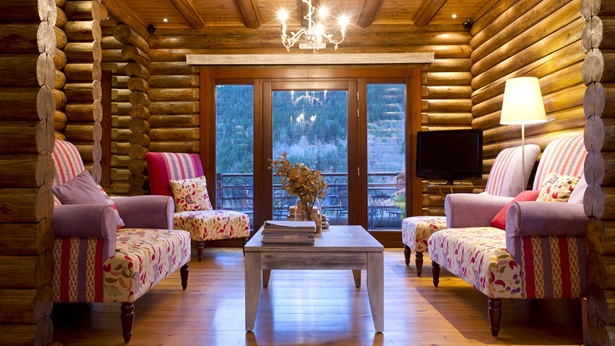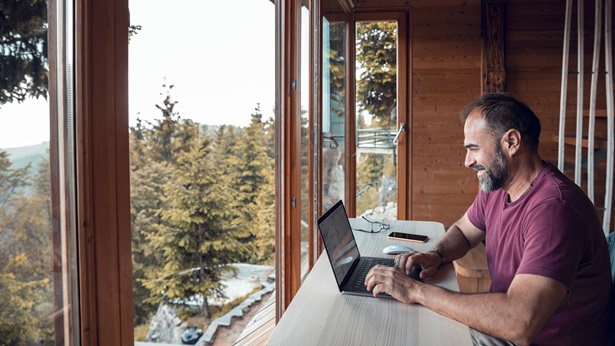Discover How Log Homes Meet Green Building Guidelines
Why Log Homes are the Original Eco-Friendly Building Material
Whether the goal is to save money, fuel, the planet or all of the above, American homeowners are increasingly going green. And while the average household spends $2,000 a year on energy, log and timber home owners typically report that they spend far less than their neighbors on heating, air conditioning, hot water and lighting.
Energy efficiency is among several ways modern log and timber homes qualify as “Green” — the sustainable approach to building that started in 1970s with the belief that we can all pitch in to make the places where we live, work and play more environmentally friendly. The National Association of Home Builders Green Building Guidelines is to use less energy during and after construction, use renewable resources whenever possible, limit C02 or “greenhouse gas” emissions and create indoor environments free of mold, formaldehyde, carcinogens, and other allergens.
The most obvious factor that makes engineered log and timber homes “green” is their building material — solid timbers grown from trees — is the original renewable resource. During the milling process, manufacturers utilize all portions of the log, from bark and other sources for mulch, scrap from cut-offs for raw material used in carvings and other home products, sawdust used by farmers as bedding material, etc. Log homes are typically arrive at the job site in one or two trailers, dramatically reducing the amount of fuel consumed by multiple deliveries from dozens of contractors as with conventional construction, says the Log and Timber Homes Council, an association of the most trusted log and timber home manufacturers in the U.S., Canada and beyond.
Log homes require less energy and man-made materials than conventional construction. With the completion of a log and timber home, you have walls that serve both the structural and insulating needs of a home in one material. This is contrasted with conventional construction, which employs a variety of building materials to create thermal envelope. This includes products from siding, house wrap, plywood, dimensional lumber, insulation, drywall, and paints in traditional homes.
Heating and Air Conditioning
The massiveness of the logs plays a vital role in conserving energy. According to studies by the University of Maine at Orono, the logs absorb heat energy during the day and radiate it at night to even out the temperature, which makes the occupants feel more comfortable while using less energy.
In addition to the benefits of solid timber construction, Log and Timber Homes Council member companies engineer their log wall joinery and roof systems to eliminate air infiltration and moisture, conserve energy and increase comfort. This engineered approach continues with every product included in a log and timber home package such as brand-name, double-paned windows and patio doors with low-e glass, proper venting and sub-flooring structures.
Engineered for Energy Conservation and Safety
Companies that belong to the Log and Timber Homes Council are up on latest developments in building technology and safety and maintain relationships with suppliers of roofing materials, heating systems, windows and other components. Council members constantly test and evaluate newer components to make sure they contribute to energy efficient, safe and trouble-free homes. Even the interior and exterior stains and finishes are evaluated for their suitability as solid timber coatings and to make sure they meet low Volatile Organic Compound (VOC) clean air standards, in their quest for the ultimate green home.
The Builder
While a green philosophy begins with the log and timber home manufacturer at the design stage, it has to continue with the builder who erects the home. The Log and Timber Homes Council’s parent organization, the National Association of Home Builders (NAHB), has been getting local builders on board by providing them with the knowledge they need to build green. As part of its effort, NAHB has partnered with the International Code Council to develop a consensus committee based Green Building Standard that provides a practical, nationally recognized baseline for resource-efficient, cost-effective home building.
The NAHB Green Building Standard and Certification Program addresses seven key green construction areas including site, resource efficiency, energy efficiency, water efficiency, indoor environmental quality, homeowner education, and global impact. Direct ways log and timber home owners can reduce their footprint include less impact on natural features and vegetation during building site preparation, choosing environmentally friendly components for subflooring, trusses and other conventional materials that go into a log and timber home, choosing energy-efficient appliances, conserving water with low-flow plumbing fixtures and taking steps to increase occupant comfort and indoor environmental quality.
Homeowners
Log homeowners play a big part in going green too. These individuals embrace nature and consider their homes permanent dream homes where they are willing to invest in energy efficiency upfront to reap savings over the years. Their design preferences lean toward open floor plans that allow for the flow of warmth throughout the home — in many cases, a wood-burning stove is the principal heat source.
From the manufacturer, to the builder to the homeowner, log and timber homes are doing their part for a greener planet. Thankfully, log and timber home construction is and always has been green. With new technologies and products available, log and timber home owners can go the extra step to make their homes even greener.



